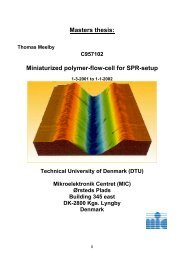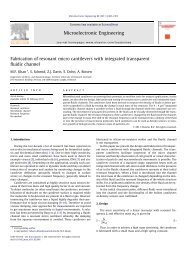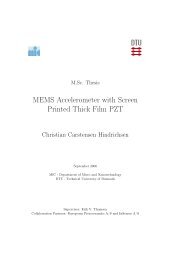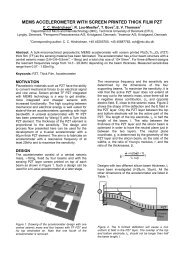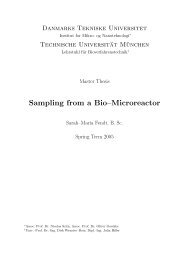Prototyping of microfluidic systems with integrated ... - DTU Nanotech
Prototyping of microfluidic systems with integrated ... - DTU Nanotech
Prototyping of microfluidic systems with integrated ... - DTU Nanotech
You also want an ePaper? Increase the reach of your titles
YUMPU automatically turns print PDFs into web optimized ePapers that Google loves.
Abstract<br />
In recent years, the use <strong>of</strong> polymer materials in the field <strong>of</strong> micr<strong>of</strong>luidic<br />
<strong>systems</strong> and so-called ’lab-on-a-chip’ <strong>systems</strong> has increased. Silicon,<br />
the material traditionally used for the fabrication <strong>of</strong> such <strong>systems</strong>, is<br />
not compatible <strong>with</strong> for instance blood or harsh chemicals, while many<br />
polymers have the desired properties. A number <strong>of</strong> standard polymers<br />
like poly(methyl methacrylate) and polydimethylsiloxane have been<br />
investigated, but also new polymer types <strong>with</strong> e.g. superior optical or<br />
chemical properties have emerged in micr<strong>of</strong>luidic research.<br />
The lab-on-a-chip <strong>systems</strong> integrate fluidic handling and measurement<br />
on a single chip, and both optical and electronical components can<br />
be embedded. For polymer micro<strong>systems</strong>, integration <strong>of</strong> optical waveguides<br />
can be achieved by structuring polymers <strong>with</strong> different refractive<br />
indices.<br />
This thesis treats aspects <strong>of</strong> prototyping and fabrication <strong>of</strong> micr<strong>of</strong>luidic<br />
<strong>systems</strong> in polymers, mainly in the cyclic olefin copolymer Topas.<br />
This relatively new polymer is resistant to a large number <strong>of</strong> chemicals<br />
and to strong acids, making it suited for micr<strong>of</strong>luidic <strong>systems</strong> used e.g.<br />
for long term waste water monitoring. The high refractive index and<br />
other good optical properties makes it suited for <strong>integrated</strong> optics in<br />
micr<strong>of</strong>luidic <strong>systems</strong>. Also, the engineerable glass transition temperature<br />
is an advantage, when making single-polymer <strong>systems</strong>.<br />
During the project existing fabrication methods have been adapted<br />
or improved for use <strong>with</strong> Topas, so that a number <strong>of</strong> tools for rapid<br />
prototyping <strong>of</strong> this polymer is now available. These tools include:<br />
• Micro milling <strong>of</strong> fluidic channels and optical waveguides <strong>with</strong><br />
dimensions down to 25 µm.<br />
• Spin coating <strong>of</strong> polymer layers on polymer substrates <strong>with</strong> a thickness<br />
from 100 nm to 20 µm. The spin coat layers act as a glue for<br />
ii



